Overall rating: 7/10 see why at the end of the report | comparison of all my races
It was still the middle of the night when my alarm went off at 2:30am on the morning of April 6, 2024. As always before a big race, I didn’t sleep too well and was rather relieved it was finally time to get this day going: Running my 19th marathon, this time in mountainous Southern Nevada, just outside of Las Vegas. Mt Charleston Marathon, part of the Revel marathon series, was going to be the season starter. I also wanted it to be my A-race as a second attempt to qualify for Boston after last year’s five-minute buffer and a finish time of 3h04m had not been enough to participate in America’s oldest marathon.
Not your regular marathon
This is why I registered for another fast course – on paper, a net downhill of 1600 meters sounds wonderful and promising to achieve personal bests. And yet, they come with their own unique challenges and today’s race would turn out to be harder than even some hilly courses I ran in the past, only marginally slower.
Point-to-point races like this one require quite some additional logistics compared to single- or multi-loop events where the start and finish line share the same location. Today, almost 2000 runners needed to be transported to the starting area 42 kilometers away up in the mountains. The event was scheduled to begin at 6 in the morning and everyone was asked to board one of the countless shuttle buses by 4am, long before sunrise.
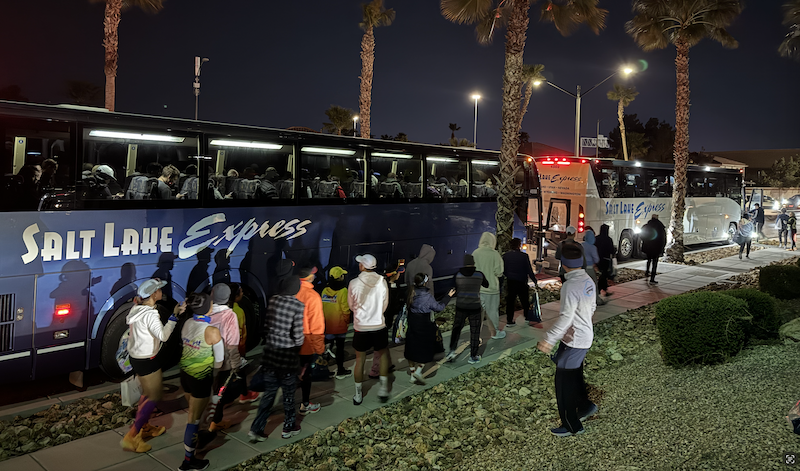
Getting up at 2:30 sounded about right. After so many marathons your morning routine may be just that, a routine, but the race jitters are real, every single time. Every competition is different, and each event in the past had its own unexpected situation thrown at me: frozen hydration; ankle deep mud; uncooperative stomach; chafing; blisters; or a combination of all the above. Two unknowns kept me up last night. First: was my limited training enough? Since my last race in February, I’d been dealing with discomfort in my right shin, especially after long runs, and I had to reduce both intensity and volume quite a bit. Second: would three to four hours of downhill running on asphalt cause any more serious damage, causing me to abort the event half-way through? Spoiler: neither would turn out to be an issue, something completely different though almost made me DNF.
Mountain shuttles
It was somewhat chilly at 4am on the dark bus parking lot in the very North-Eastern part of town. Nothing here reminded of being in Las Vegas, the city of lights in the desert — no blinking casino fronts or run-down fast-food chains, no drunk tourists, roaring sports cars, screaming billboards of magic shows, and no tourist-hunting Playboy bunnies or superheroes desperately trying to get tipped for ending up on the random smartphone picture. Just hundreds of runners, waiting in line to either the washrooms or the bus. I got in line for the latter late, trying to board one of the last buses to avoid having to wait too long in much colder weather up in the mountains. The drive there would take about 50 minutes and you could tell everyone else’s tension and nerves. It still was too dark outside to make out any of the surroundings, but one could feel how the engine had to constantly push the vehicle uphill. The longer the ride, the harder it became to imagine to be running that whole distance just a little while from now.
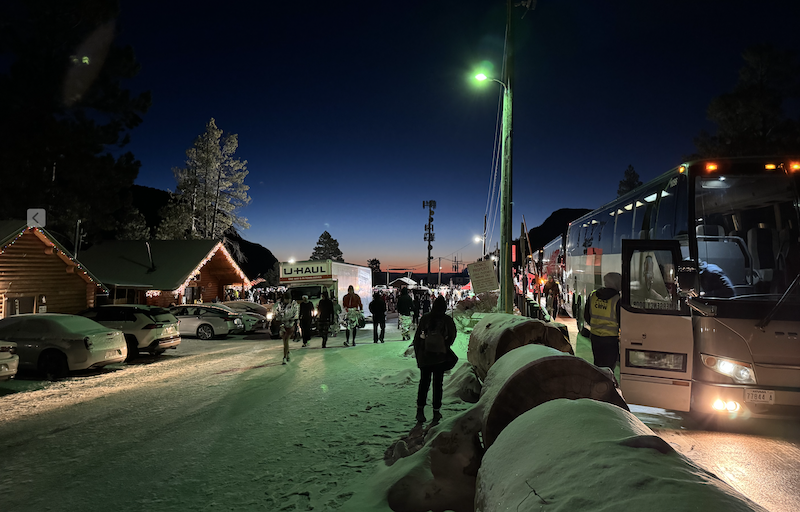
We reached the top at around 5:15. before leaving the bus I put on an extra sweater and a jacket, two hats, a thick neck warmer and some extra gloves; most of which was supposed to just keep me warm over the next 30 minutes. It was -12ºC up there at an elevation of 2300m, with a windchill even colder. Not that I wasn’t used to these low temperatures, but the fact that it would be warming up to more than 30º above what it was now made it all a bit more complicated. How little clothing can you tolerate up in the cold, and how much down in the sun? Weirdly enough, I did not have any last-minute race strategy thoughts on my mind this time; I knew I had to average below 4:30 minutes per kilometer to meet my Boston qualifying standard, below 4:25 to get a comfortable buffer and a marathon PB, and well below 4:20 to miraculously run a sub-3 hours marathon. Given the bumpy training season and my suboptimal physical conditions on the one hand, and my experience of 18 marathons on the other, I knew, that everything was possible, but also that anything could happen.
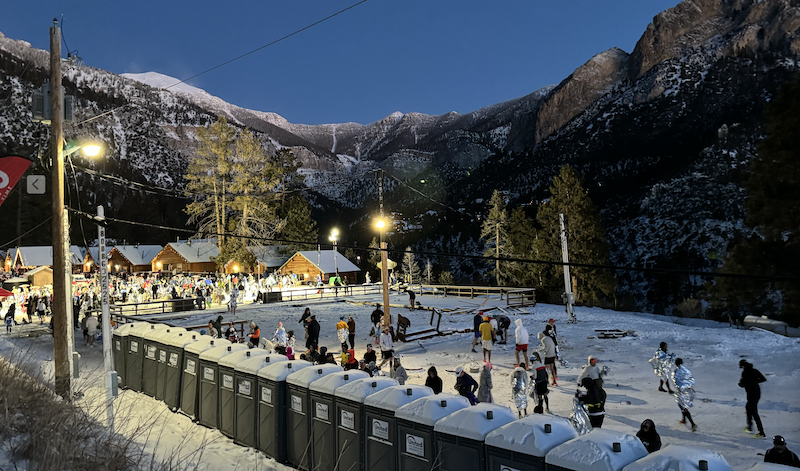
Ten minutes before the start I put most of the extra layers in my drop-bag and seeded myself in one of the faster corrals; wearing running pants, a long sleeve and a short sleeve shirt, my hydration vest, an old, disposable sweater on top, gloves, a thin hat, and a thin neck warmer. Much more than some the other athletes — one brave fellow from Colorado was wearing nothing but shoes and shorts!
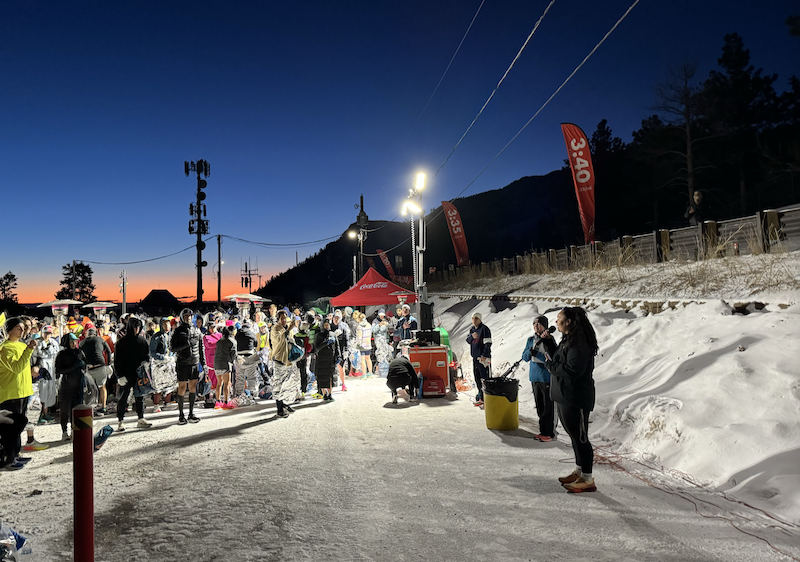
Off to a cold start
At 6am sharp the race was on! All the jitters were gone in an instance and my brain went from doubting to racing mode as soon as I pushed that “Start”-button on my Garmin watch. The first couple hundred meters were quite narrow, curvy, and slightly uphill. As always, half of the crowd seemed to have seeded themselves way too far in the front of the field and zigzagging my way through the masses on somewhat icy, unlit roads without slipping or stepping into someone else’s heels kept me busy for a couple of minutes. The first kilometer clocked at 4:58 minutes — way below target, but there were 41 more to run and catch up. My legs felt surprisingly good; just two until two days ago I couldn’t do a single training run without any shin pain, and yesterday some discomfort in the other leg’s calf was making me nervous. I didn’t give it too many thoughts. The start of a long-anticipated race in a big crowd usually causes Adrenalin to flood your blood stream, numbing whatever otherwise would be hurting. Or maybe it was just too cold still.
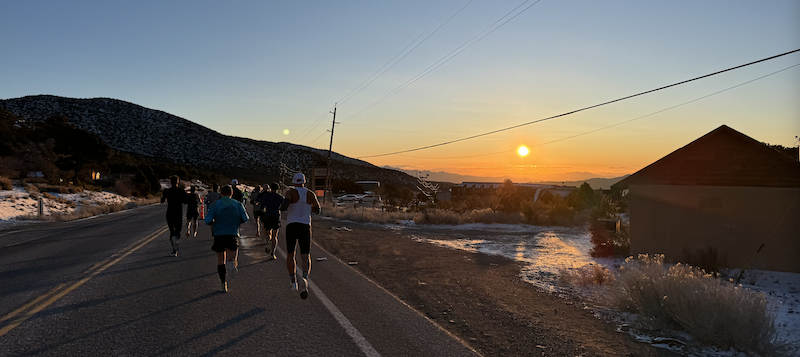
Soon after the start, the course followed a 180 degree turn towards East, right into the rising sun which was still slightly below the horizon. The scenery was just beautiful. Surrounded by snow-capped mountains, dark skies, and stars above, and a colorful dawn in front, and a smooth road below your feet — which quickly got steeper and steeper. I couldn’t help but run fast, going at a 4:10 pace almost felt effortless even though I knew that sooner or later my quads would hate me for that. Hopefully much later. For now, all was great. Kilometer after kilometer I ran way below pace target, while I was able to keep my heart rate around a sustainable 160 beats per minute. The road slightly winded through the canyon, descending between 4 and 6%. At that grade, you definitely feel that you’re running downhill, and each step pounds into your knees and quads. Gravity wants you to take its advantage and speed up, but your running muscle memory (and common sense) tells you to slow down while neither of which really works.
I am flying!
After 20 minutes the sun made it over the mountain tops and my body warmed up. 4:10, 4:05, even some kilometers under 4 minutes. This feels great! But for how long? The field of runners stretched out quite a bit. It was not crowded anymore, but enough athletes were on close to not feel lonely. In smaller events you sometimes loose that race feeling, not seeing another runner for miles on end. Not today. There was always someone to overtake, or someone to be passed by. Water stations offered hydration and calories every two to three kilometers. Over the years I’ve gotten used to running with my own supplies, though, and kept sipping regularly on my 1.5 liters and 500 calories of water-Tailwind-powder mix that I carried on my back.

Ten kilometers down, in just about 41 minutes. No pain yet, no major discomfort. It got warmer and I decided to discard of my old sweater at one of the water stations. Compared to the others I was still wearing more than most yet did not feel overdressed. For someone who prefers to over- rather than underdress this was a good choice of layers after all.
The snow along the road was long gone, and the surroundings started looking a bit more like desert, a bit less like mountain range but we were still in the middle of Kyle Canyon. The wind started to pick up, blowing from the north-west and mostly coming from the side, with some occasional burst of headwind. Could be worse, and if it kept its direction, that would mean a tailwind on the last portion of the course.
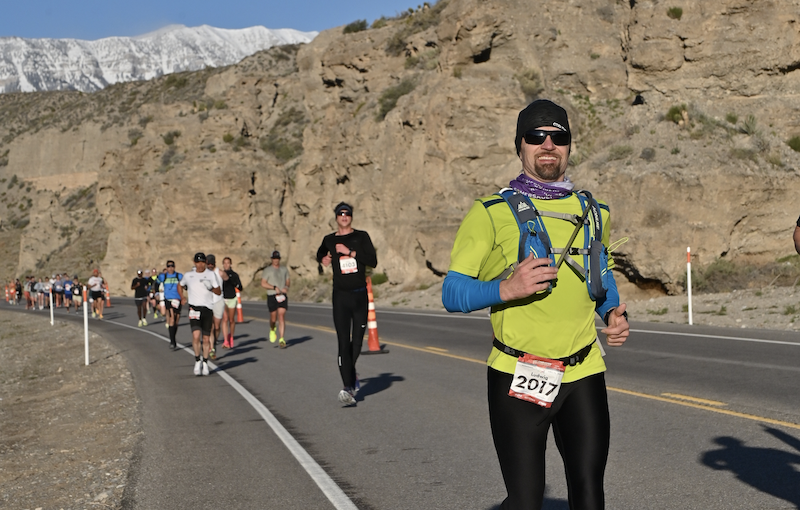
When I crossed the halfway point at 21 kilometers, I was still pacing below target. Running a half marathon personal best in a marathon race is somewhat unusual, but with only 1h27m on the clock I (more jokingly than seriously) played with the idea of ending this event in under three hours. If anything, that fast first half gave me a good confidence boost, and a realistic hope to finish at least around what I hoped for in the first place. But then, of course, the expected unexpected started happening.
The fun’s over
While I did not feel any discomfort at all for more than 20 kilometers and was most concerned about my shin pain to come back at some point, it was my socks that first reminded me of how annoying those little inconveniences can get. Something started chafing on my left foot. And you know that this will either get worse from now on for the rest of the race, or mysteriously disappear at some point. Most important was now not to focus too much on it. It didn’t take long until a much bigger problem showed up, anyway, intending to turn all the fun into struggle: both of my quads had had enough of the pounding. I was expecting those muscles to start protesting at some point — it’s been not even a year ago that I ran a downhill marathon in Washington State. The type of pain was very familiar. I knew it would get worse all the way to the finish, and that at some point it would start feeling as if your body’s largest muscles could seize up and cramp or just simply malfunction at any time. There was only one considerable difference: last year this only started with 8 kilometers to go; today I had more than twice as much left.
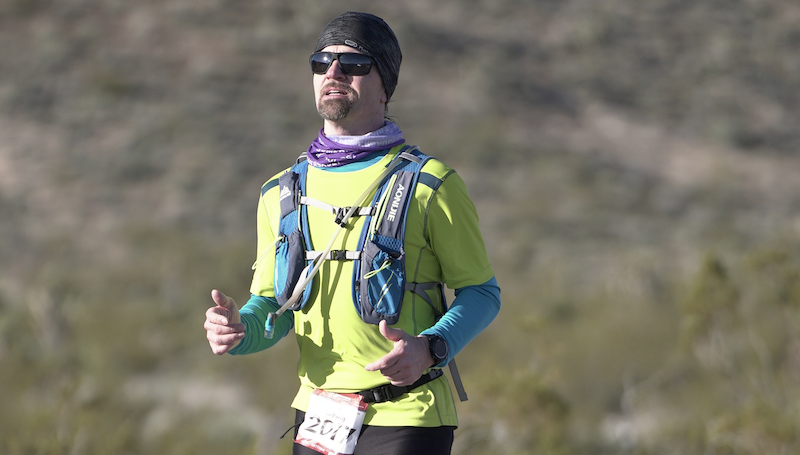
That was going to be a long day. The downhill grade had gotten slightly flatter, but my legs were still pounding into the asphalt more than on an even or an uphill course. My mind started doing what it always does during the second half of a long race, especially when it starts getting complicated: It calculated potential finish times. “If I start walking the rest, I’d still finish in under X hours” This kept me busy for a while, and while my legs were starting to hurt more and more, they were still moving. At this time, the wind had picked up quite a bit and caused me to fight it sideways. My moral was still doing okay at this point — I still was on target overall. It didn’t take long until that changed, though. Each step became harder and harder, both of my quads started burning to the point that I just could not keep my pace, no matter how hard I tried. I continuously slowed down kilometer after kilometer, expecting muscle cramps to abruptly ending my race at any time now. More and more runners started passing me.
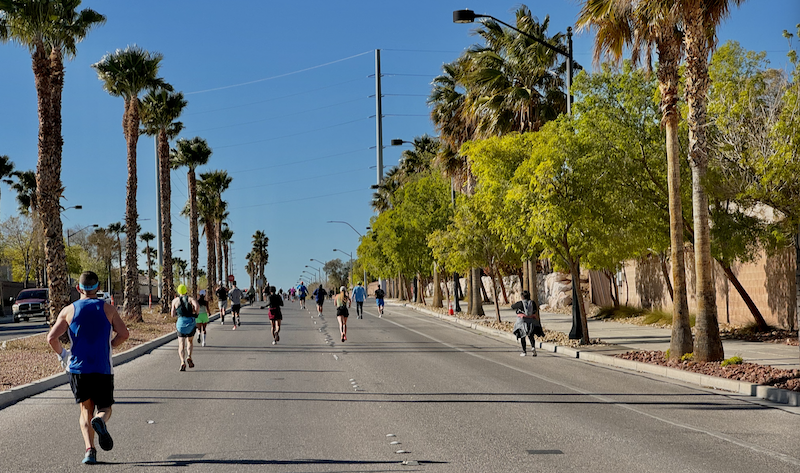
Pushing through
Soon I decided to walk the water stations which were positioned every 3-4 kilometers; giving my legs some mini breaks and taking in some cold sips of electrolytes and fresh water, to supplement the Tailwind mix I was carrying with me. Not too long ago I had my first Maurten gel, but my problem was not a calorie deficit. Energy-wise I felt surprisingly well, my lower back was doing better than in prior races (maybe a result of an increasing amount of core muscle workouts that I started adding into my training routine?), the feet chafing had stopped, and my stomach was taking, and keeping, all the fluids I put in. It was the quads that made it almost unbearably hard to keep going. And yet, I consequently picked up running after each water station somehow.
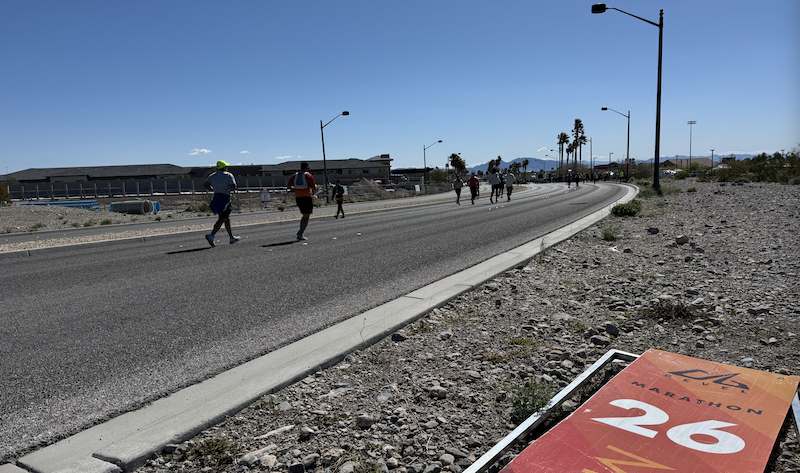
The final eight kilometers were a painful slog. Running at a pace of around 5:15 to 5:30 minutes per kilometer doesn’t sound too bad, but given that we’re still going slightly downhill, and even turning south, taking advantage of what was now a tailwind, it felt like standing still. The legs wouldn’t do what my mind tried telling them. The dull surroundings didn’t help too much either. We arrived in North Las Vegas, which is dominated by wide roads, huge intersections, interstate underpasses, billboards, and a typical suburban flair. There were almost no spectators on the entire route, which I did not miss in the mountains, but back down in the city, towards the end of the course, it would have helped to get some mental power-ups from supportive cheerers along the way. I kept calculating what was still possible; a PB was off the chart by now, that was for sure. But when I had 4 more kilometers to go, I suddenly realized that I’d potentially be able to make it to my BQ standard, if only I would keep running, not slowing down. That gave me quite the push and I decided to not stop at the final water station and instead trying one last time to win the mental battle over the physical struggles.
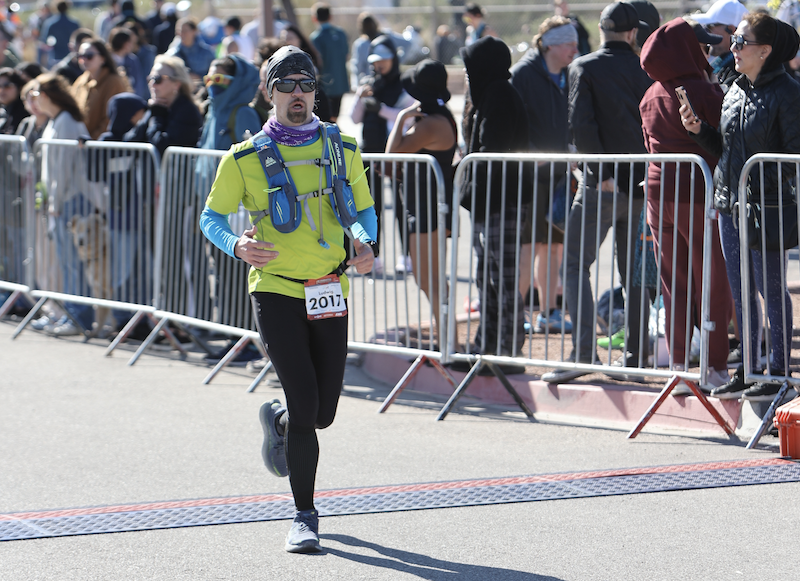
Finish with a technical BQ
It worked! The legs picked up the pace while my ears picked up the finish line announcer in the distance, and my eyes kept peeking at my Garmin display every 200 meters. Over the last kilometer I finally recognized some cheering crowd on the side of the streets, and when I saw the final turn just a couple hundred meters down the road those endorphins started kicking in early, providing the needed energy and last bit of kick to finish the race — crossing the line just 35 seconds under my Boston qualifying standard of 3 hours and 10 minutes. And as happy as I was to finish my 19th marathon, as much I already was looking forward to number 20. What a weird brain runners have; everything hurts, but to some extent, the pain is already forgotten before it has even started fading away.

After getting my medal, a bottle of cold water and some chocolate milk I found myself a sunny spot to just sit and inhale the finish line atmosphere. The minutes just after finishing feel extremely surreal. You mind is trying to reflect on what the body just accomplished over the past three hours, endorphins are flooding your cells, while at the same time your muscles finally realize that they’re done working now to the point that they’re not willing to move almost at all anymore. You cross the finish line and stop, and even though you’d just been running until 30 seconds ago, you hardly can even walk all the sudden. It is enjoyable, too, to see that most finishers seem to share those sensations, some to a higher extent than others. Just sitting there, watching people move after they had just ran a whole marathon, whether it’s their first or hundredth, whether it’s their best or their slowest; watching other athletes finish their race creates such an interesting feeling of belonging to that somewhat crazy breed of human, it’s very liberating, and this is probably one of the main reasons I’ll continue doing this sport.
2024 marathon season has started!
Aftermath
- Running downhill is much harder than you might think; at first you feel weightless, but you really must watch your quads. It’s not easy to train for this either.
- Even after 19 marathons, there’s always something unexpected to happen.
- At the same time, my running and racing experience really help to be a bit more relaxed, have realistic expectations and deal with unpleasant situations.
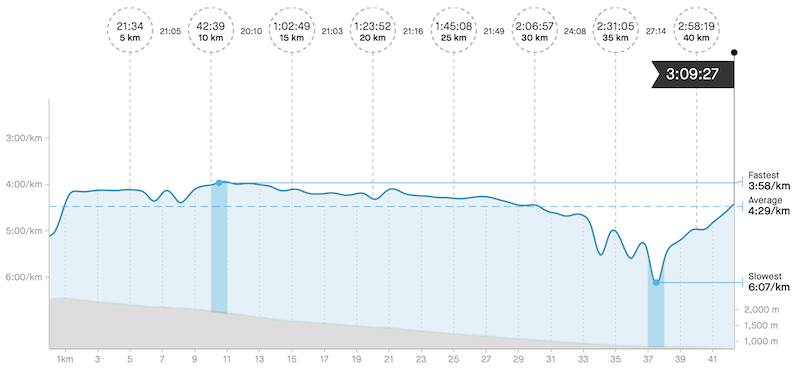
About the race itself
- Revel Mt Charleston is a very well-organized race – a great expo, bus shuttles, and finish area were all very enjoyable.
- They offer very generous cancellation and referral options, but the overall price is quite expensive.
- The finisher shirt is the best one I’ve gotten so far! High quality, thin functional fabric, cool design, only one sponsor logo on it. The medal is awesome, too!
- Water stations every two miles, top
- Photos and a personalized finisher video are included in the registration
- There are enough timing mats along the course to get your splits afterwards, but in some crucial areas mats were missing (i.e., when athletes had to run a little loop, that could easily be cut short).
- Finish area nice and big, and some good choices of post-race snacks. Only thing missing was chairs to sit on, or shade to get some sun protection.
Stats
Total distance: 42.2km
Total time: 3:09:25
Average pace: 4:29min/km
Average HR: 168
Total elevation: -1600m
Calories burned: 2600
Calories consumed: 700
Fluids consumed: 1400ml
Temperature: -13ºC to +17ºC
Revel Mt Charleston Marathon Las Vegas, NV, USA | |||
Overall rating | |||
 | 2024 |  | 2,000 |
 | Spring |  | Point-to-point |
 | 6:00AM |  | Downhill (-1600m) |
 | -13ºC at start |  | Asphalt |
Individual ratings* | |||
Spectators | Scenery & views | ||
On-course nutrition | Overall organization | ||
Medal design | Finisher shirt | ||
Timing and splits | Value | ||
What stood out Temperature change of 30 degrees from start to finish, between -13 and +17 degrees. Beautiful views during the first half, and somewhat dull suburbia over the final 10 kilometers. Photographs and finisher video included in pricing, and very generous cancellation and referral policies. | |||
*Individual ratings: details see below
Note that those ratings are highly subjective and only based on the last time I personally ran that particular race. Some things like medal or finisher shirt design can highly fluctuate from year to year. Please feel free to leave a comment or contact me for any more details.
Spectators: How many spectators along the course? How much action and welcome mental distraction for runners, especially during the second half of the course was offered? Higher ratings for more spectators, action, music, etc.
On-course nutrition: Number of water stations and variety of nutrition offered.
Medal design: Important aspects for me: Does the medal to some extent resemble the location or the course? Does it show the distance and date of the event? Does it have a reasonable size and shape? How creative is the design? Does it look cheap?
Timing and splits: How many timing mats were on the course? Were there timing mats in key areas to prevent shortcuts and to provide timing splits?
Scenery/views: How much visual distraction and awe do you get as a runner along the course. Usually one-loop or point-to-point races provide more variety than multi-loop courses. I value natural scenery higher than industrial or suburban areas.
Overall organization: How well was the whole event organized; including communication before and after the event, available course information, expo, additional events, pre- and post-race announcers, start and finish line area design, etc.
Finisher shirt: Design of the shirt, the type of fabric, is it full of sponsors?
Value: What you get vs what you paid. Some races are super expensive and you don’t even get a shirt, others are reasonably priced and even include a pasta party the day before. High ratings either mean cheap entry or lots of goodies.


Hi Ludwig. Great report. I used to live in Ottawa and I’m in Washington now. HowI miss cycling in Gatineau Park too! As pf now, I would love to hear your reviews on how easy or difficult Mt. Charleston is compared to the Tunnel Marathon. I know you had some injury prior to running the race, but you did a very awesome time regardless of your injury. I did the tunnel last year and ran the course multiple times from training and racing. I’ll be running the Revel Mt. Charleston this April to get a good buffer for my BQ and just curious on how fast it is to run a 4% gradient compared to the tunnel which has a 2% and a gravelly surface. Thanks for your insights.
Thanks for your comment!
I found Mt. Charleston much more difficult than the Tunnel marathon. In many aspects: the temperature difference; the much steeper downhill grade; and the asphalt vs gravel. While the first half felt quite nice, the constant pounding really destroyed my quads; the Tunnel was much more tolerable. I ran the Tunnel marathon more than 5 minutes faster than Mt. Charleston. So my biggest advice would be to really train some 4-5% downhills on asphalt, if you can!